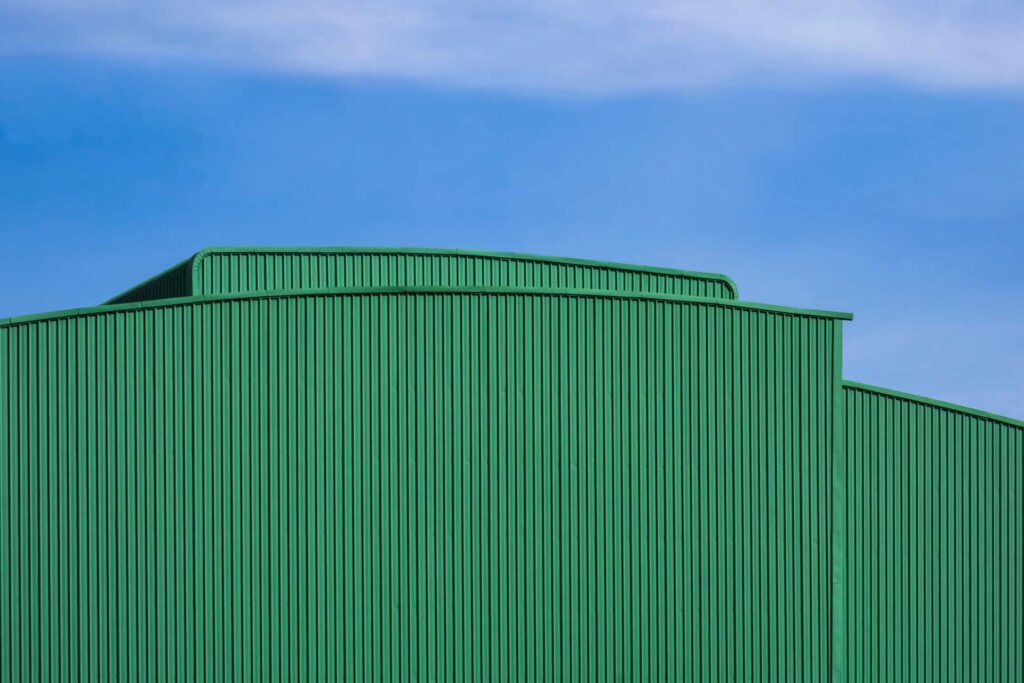
Contents
When it comes to efficient metal warehouse construction, understanding the key elements that drive success is essential. You might be surprised at how a combination of creative design strategies, smart material choices, modern construction technologies, thoughtful layout planning, and eco-friendly energy solutions can greatly impact the overall efficiency of your project. By focusing on these essential factors, you can pave the way for a warehouse that meets your immediate needs while also laying the groundwork for long-term operational excellence.
Key Takeaways
- Utilize insulated metal panels for energy efficiency.
- Opt for high-strength steel alloys for durability.
- Incorporate advanced construction technologies for precision.
- Design efficient layouts for workflow optimization.
- Integrate renewable energy sources like solar panels for sustainability.
Energy-Efficient Design Strategies
Utilize insulated metal panels and high-efficiency lighting systems to improve the energy efficiency of your metal warehouse construction project. Passive design elements, like proper insulation and strategic placement of windows for natural lighting, can greatly reduce the energy consumption of your warehouse.
Integrating renewable energy sources such as solar panels on the roof can further decrease your dependence on non-renewable energy.
When considering the energy efficiency of your warehouse, it’s essential to focus on passive design strategies that leverage the building’s natural surroundings. By positioning the warehouse to maximize sunlight exposure during the winter months and minimize it during the summer, you can control the internal temperature without heavily relying on heating or cooling systems.
Moreover, investing in energy-efficient lighting systems with motion sensors can help lower electricity usage when warehouse areas aren’t in use.
Renewable energy technologies, like solar panels or wind turbines, can offer a sustainable power source for your warehouse. By producing electricity on-site through these renewable sources, you can reduce your overall energy costs and minimize your environmental impact.
Incorporating these energy-efficient and renewable energy strategies into your metal warehouse construction project can benefit your bottom line and showcase your dedication to sustainability within the community.
Optimal Material Selection
When selecting materials for your metal warehouse construction project, consider factors like material strength and durability.
The materials’ strength will impact the warehouse’s structural integrity, ensuring it can withstand heavy loads and external stresses. Additionally, choosing materials with a high durability factor will contribute to the longevity and low maintenance requirements of the warehouse.
Material Strength
Selecting materials with the best strength characteristics is essential in ensuring the structural integrity and longevity of a metal warehouse during construction. High tensile strength materials, such as steel alloys like ASTM A992 or A500, are commonly used due to their ability to withstand heavy loads and harsh environmental conditions.
When choosing materials for your metal warehouse, consider the specific requirements of the project, including the expected loads, weather conditions, and the desired lifespan of the structure.
Steel is a popular choice for metal warehouse construction due to its high strength-to-weight ratio, allowing for lighter structural elements without compromising on durability. Additionally, steel’s malleability and ductility make it easier to work with during the construction process, enabling complex designs and ensuring a precise fit of components for best structural integrity.
Durability Factor
Considering the significance of material strength for structural integrity in metal warehouse construction, the durability factor plays a crucial role in determining the best material selection for long-term performance.
When evaluating the durability factor in metal warehouse construction, there are key aspects to take into account for ideal material selection:
Material Resilience: Opt for materials that offer high resistance to corrosion, rust, and other environmental factors to ensure longevity and minimal maintenance requirements.
Strength-to-Weight Ratio: Select materials that strike a balance between strength and weight to ensure structural stability without unnecessary bulkiness, which can impact construction time and costs.
Life Cycle Cost Analysis: Conduct a thorough cost analysis considering upfront material costs, maintenance expenses, and expected lifespan to make informed decisions on the most cost-efficient option in the long run.
Material Compatibility: Verify that the selected materials are compatible with the specific environmental conditions of the warehouse site to prevent premature deterioration and costly repairs.
Advanced Construction Technologies
Utilize advanced construction technologies to improve the efficiency and quality of metal warehouse construction projects. Integrating robotics and automated assembly processes into your construction workflow can streamline the assembly of metal warehouse components to a great extent. By incorporating robotics integration, tasks such as welding, cutting, and material handling can be automated, reducing the need for manual labor and enhancing overall project efficiency.
Another innovative technology that can transform metal warehouse construction is 3D printing, also known as additive manufacturing. 3D printing enables the production of intricate metal parts with precision and speed, providing a new level of customization and flexibility in warehouse design. By utilizing 3D printing for specific components or even entire structures, construction time can be shortened, material waste minimized, and design possibilities expanded.
Furthermore, these advanced construction technologies improve efficiency and enhance the overall quality of metal warehouse construction projects. The precision and accuracy offered by robotics integration and 3D printing can result in tighter tolerances, improved structural integrity, and, ultimately, more resilient metal warehouse structures.
Embracing these technologies can give your construction projects a competitive advantage in terms of both speed and quality.
Efficient Layout Planning
Efficient layout planning plays a crucial role in optimizing space utilization and workflow efficiency for metal warehouse construction projects.
When planning the layout of your metal warehouse, consider the following key aspects:
Zone Segregation: Divide the warehouse into zones based on the frequency of item retrieval. Place fast-moving items closer to the shipping area for quick access, while slower-moving inventory can be stored further back. This zoning strategy enhances workflow optimization by reducing travel time within the warehouse.
Vertical Space Utilization: Maximize vertical storage space by using mezzanines or high-stacking racks. This approach allows you to store more inventory without expanding the warehouse’s footprint, ultimately improving space utilization efficiency.
Optimized Aisles: Design aisles wide enough for forklifts and other equipment to maneuver easily. Ensuring proper aisle width prevents traffic congestion and facilitates smooth material handling processes, contributing to overall workflow optimization.
Flexible Layout Design: Create a layout that can adapt to changing inventory needs. Utilize modular shelving and adjustable storage systems to accommodate fluctuations in stock levels. Flexibility in layout design supports efficient space utilization and enables smooth workflow adjustments as required.
Sustainable Energy Solutions
When considering enduring energy solutions for metal warehouse construction, it’s pivotal to explore options like:
- Solar panel integration
- Energy-efficient lighting
- Eco-friendly insulation
Solar panels can harness the sun’s energy to power the warehouse, reducing dependence on traditional electricity sources. Energy-efficient lighting systems and eco-friendly insulation materials further contribute to a more enduring and cost-effective warehouse operation.
Solar Panel Integration
Consider incorporating solar panels into the design of your metal warehouse for an eco-friendly energy solution that can help reduce operational costs in the long term. By enhancing solar panel efficiency and utilizing rooftop integration, you can harness renewable energy and drive notable cost savings over time.
Solar Panel Efficiency: Ensure you choose high-performance solar panels to maximize energy production and make the most of the available space on your warehouse roof.
Rooftop Integration: Integrate solar panels seamlessly into the design of your metal warehouse to make the most of the rooftop space and optimize sun exposure for increased energy generation.
Renewable Energy Source: Shifting to solar power allows your warehouse to rely on a clean and renewable energy source, reducing your carbon footprint and contributing to a more environmentally friendly operation.
Cost Savings: By generating your electricity through solar panels, you can significantly decrease your energy bills and even benefit from potential incentives or rebates for utilizing renewable energy sources.
Energy-Efficient Lighting
Implementing energy-efficient lighting solutions in your metal warehouse can decrease electricity consumption and enhance sustainability practices within your facility. By incorporating lighting control systems and energy-saving technologies, you can create a more environmentally friendly workspace while also cutting down on operational costs.
Here is a breakdown of some key elements to take into account when implementing energy-efficient lighting in your metal warehouse:
| Lighting Control | Type of Lighting |
|---|---|
| Motion Sensors | LED High Bays |
| Daylight Harvesting | T5 or T8 Fluorescent Lights |
| Timers | Metal Halide Fixtures |
Eco-Friendly Insulation
To enhance the energy efficiency of your metal warehouse, eco-conscious insulation solutions can be strategically integrated to improve environmentally friendly energy practices and reduce thermal loss.
Implementing insulation made from upcycled materials is an excellent way to diminish environmental impact while enhancing the building’s thermal performance.
Green roofing, which involves installing vegetation on the roof, can further improve insulation by providing natural cooling and reducing heat loss in winter.
Here are four key strategies to ponder for eco-friendly insulation in your metal warehouse:
Upcycled Insulation Materials: Utilize insulation materials made from repurposed products to reduce waste and lower the carbon footprint of your warehouse.
Green Roofing: Reflect on installing a green roof to improve insulation, reduce energy consumption, and enhance the overall sustainability of your warehouse.
Air Sealing: Ensure proper air sealing to prevent thermal leakage and maintain a consistent indoor temperature, reducing the need for excessive heating or cooling.
Reflective Roof Coatings: Apply reflective coatings on the roof to reduce heat absorption, minimize cooling needs, and prolong the roof’s lifespan.
Streamlined Project Management
Efficient metal warehouse construction demands a well-coordinated project management approach to secure timeliness and cost-effectiveness. Project scheduling plays a crucial role in ensuring that tasks are completed in the right sequence and within the allocated time frame. By creating a detailed project schedule that outlines each step of the construction process, you can effectively manage resources and maximize workflow.
Team coordination is another key aspect of streamlined project management. Assigning specific roles and responsibilities to each team member helps establish clear lines of communication and accountability. Regular team meetings can facilitate collaboration and ensure that everyone is aligned with the project’s objectives.
Encouraging an open exchange of ideas and feedback among team members can lead to creative solutions and improved efficiency. Utilizing project management software can streamline communication, document sharing, and task tracking. These tools enable real-time updates on project progress, allowing for quick decision-making and adjustments as needed.
Recap
The key to efficient metal warehouse construction lies in the strategic synchronization of energy-efficient design strategies, best material selection, advanced construction technologies, efficient layout planning, and eco-friendly energy solutions.
By implementing these elements in a harmonious manner, metal warehouses can be constructed with durability, energy efficiency, and cost-effectiveness in mind.
Remember, meticulous management and methodical execution are essential for achieving success in the construction of metal warehouses.
Recent Posts
Benefits of Using Metal in Construction Projects
Isn’t it fascinating how a simple material can transform the landscape of construction? When you
What Are the Benefits of Durable Metal Construction?
While traditional building materials may offer charm, they often fall short in durability compared to
Benefits of Choosing Strong Metal for Construction
When it comes to bolstering your construction projects, opting for strong metal for construction can




